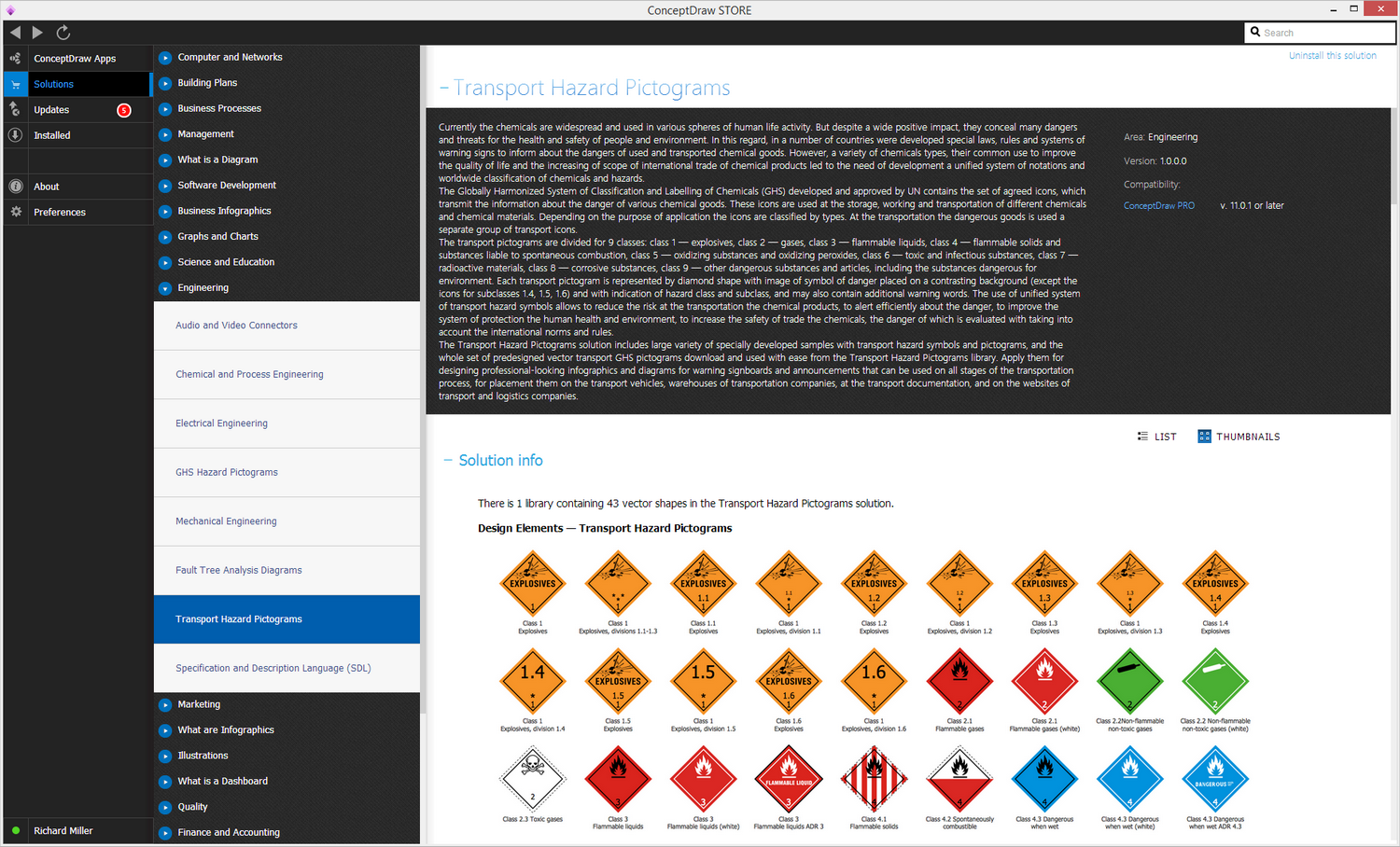- Electric and Telecom Plans Free
- Fire and Emergency Plans Free
- Floor Plans Free
- Plant Layout Plans Free
- School and Training Plans Free
- Seating Plans Free
- Security and Access Plans Free
- Site Plans Free
- Sport Field Plans Free
- Business Process Diagrams Free
- Business Process Mapping Free
- Classic Business Process Modeling Free
- Cross-Functional Flowcharts Free
- Event-driven Process Chain Diagrams Free
- IDEF Business Process Diagrams Free
- Logistics Flow Charts Free
- Workflow Diagrams Free
- ConceptDraw Dashboard for Facebook Free
- Mind Map Exchange Free
- MindTweet Free
- Note Exchange Free
- Project Exchange Free
- Social Media Response Free
- Active Directory Diagrams Free
- AWS Architecture Diagrams Free
- Azure Architecture Free
- Cisco Network Diagrams Free
- Cisco Networking Free
- Cloud Computing Diagrams Free
- Computer Network Diagrams Free
- Google Cloud Platform Free
- Interactive Voice Response Diagrams Free
- Network Layout Floor Plans Free
- Network Security Diagrams Free
- Rack Diagrams Free
- Telecommunication Network Diagrams Free
- Vehicular Networking Free
- Wireless Networks Free
- Comparison Dashboard Free
- Composition Dashboard Free
- Correlation Dashboard Free
- Frequency Distribution Dashboard Free
- Meter Dashboard Free
- Spatial Dashboard Free
- Status Dashboard Free
- Time Series Dashboard Free
- Basic Circle-Spoke Diagrams Free
- Basic Circular Arrows Diagrams Free
- Basic Venn Diagrams Free
- Block Diagrams Free
- Concept Maps Free
- Family Tree Free
- Flowcharts Free
- Basic Area Charts Free
- Basic Bar Graphs Free
- Basic Divided Bar Diagrams Free
- Basic Histograms Free
- Basic Line Graphs Free
- Basic Picture Graphs Free
- Basic Pie Charts Free
- Basic Scatter Diagrams Free
- Aerospace and Transport Free
- Artwork Free
- Audio, Video, Media Free
- Business and Finance Free
- Computers and Communications Free
- Holiday Free
- Manufacturing and Maintenance Free
- Nature Free
- People Free
- Presentation Clipart Free
- Safety and Security Free
- Analog Electronics Free
- Audio and Video Connectors Free
- Basic Circuit Diagrams Free
- Chemical and Process Engineering Free
- Digital Electronics Free
- Electrical Engineering Free
- Electron Tube Circuits Free
- Electronic Block Diagrams Free
- Fault Tree Analysis Diagrams Free
- GHS Hazard Pictograms Free
- Home Automation and Wiring Free
- Mechanical Engineering Free
- One-line Diagrams Free
- Power Сircuits Free
- Specification and Description Language (SDL) Free
- Telecom and AV Circuits Free
- Transport Hazard Pictograms Free
- Data-driven Infographics Free
- Pictorial Infographics Free
- Spatial Infographics Free
- Typography Infographics Free
- Calendars Free
- Decision Making Free
- Enterprise Architecture Diagrams Free
- Fishbone Diagrams Free
- Organizational Charts Free
- Plan-Do-Check-Act (PDCA) Free
- Seven Management and Planning Tools Free
- SWOT and TOWS Matrix Diagrams Free
- Timeline Diagrams Free
- Australia Map Free
- Continent Maps Free
- Directional Maps Free
- Germany Map Free
- Metro Map Free
- UK Map Free
- USA Maps Free
- Customer Journey Mapping Free
- Marketing Diagrams Free
- Matrices Free
- Pyramid Diagrams Free
- Sales Dashboard Free
- Sales Flowcharts Free
- Target and Circular Diagrams Free
- Cash Flow Reports Free
- Current Activities Reports Free
- Custom Excel Report Free
- Knowledge Reports Free
- MINDMAP Reports Free
- Overview Reports Free
- PM Agile Free
- PM Dashboards Free
- PM Docs Free
- PM Easy Free
- PM Meetings Free
- PM Planning Free
- PM Presentations Free
- PM Response Free
- Resource Usage Reports Free
- Visual Reports Free
- House of Quality Free
- Quality Mind Map Free
- Total Quality Management TQM Diagrams Free
- Value Stream Mapping Free
- Astronomy Free
- Biology Free
- Chemistry Free
- Language Learning Free
- Mathematics Free
- Physics Free
- Piano Sheet Music Free
- Android User Interface Free
- Class Hierarchy Tree Free
- Data Flow Diagrams (DFD) Free
- DOM Tree Free
- Entity-Relationship Diagram (ERD) Free
- EXPRESS-G data Modeling Diagram Free
- IDEF0 Diagrams Free
- iPhone User Interface Free
- Jackson Structured Programming (JSP) Diagrams Free
- macOS User Interface Free
- Object-Role Modeling (ORM) Diagrams Free
- Rapid UML Free
- SYSML Free
- Website Wireframe Free
- Windows 10 User Interface Free
Transport Hazard Pictograms
Currently, chemicals are widespread and used in various fields of human activity. But, despite the wide positive effect, they hide many dangers and threats to the health and safety of people and the environment. In this regard, in a number of countries special laws, rules and warning sign systems have been developed to inform of the dangers of used and transported chemical goods. However, a variety of chemicals types, their common use to improve the quality of life and the expansion of the international trade in chemical products have led to the need to develop a unified labeling system and a worldwide classification of chemicals and hazards.
The Globally Harmonized System of Classification and Labeling of Chemicals (GHS), developed and approved by the UN, contains a set of agreed icons that transmit information on the dangers of various chemicals. These icons are used in the storage, handling and transportation of various chemicals and chemical materials. Depending on the purpose of use, the icons are classified by types. When transporting dangerous goods, a separate group of transport icons is used.
Transport pictograms are divided into 9 classes: class 1 — explosives, class 2 — gases, class 3 — flammable liquids, class 4 — flammable solids and substances capable of spontaneous combustion, class 5 — oxidizing substances and oxidizing peroxides, class 6 — toxic infectious substances, class 7 — radioactive materials, class 8 — corrosive substances, class 9 — other hazardous substances and products, including substances hazardous to the environment. Each transport pictogram is presented in the shape of a diamond with an image of a hazard symbol on a contrasting background (except for icons with sub-classes 1.4, 1.5, 1.6) and with an indication of a hazard class and subclass, and may also contain additional warning words. The use of a unified system of hazard labels for transport can reduce the risk of transporting chemical products, effectively alert to the danger, improve the protection of human health and the environment, improve the safety of trade in chemicals, the danger of which is assessed taking into account international norms and rules.
The Transport Hazard Pictograms solution includes a large number of specially designed samples with symbols and pictograms of transport danger, as well as a whole set of pre-designed GHS vector transport pictograms for downloading and using with ease from the Transport Hazard Pictograms icon library. Use them to develop professional-looking infographics and diagrams for warning signs and announcements that can be used at all stages of the transportation process, to place them on vehicles, warehouses of transport companies, transport documentation, and websites of transport and logistics companies.
-
Install this solution Free -
What I need to get started -
Solution Requirements - This solution requires the following products to be installed:
ConceptDraw DIAGRAM v18 - This solution requires the following products to be installed:
-
Compatibility - Sonoma (14), Sonoma (15)
MS Windows 10, 11 - Sonoma (14), Sonoma (15)
-
Support for this Solution -
Helpdesk
There is 1 library containing 43 vector shapes in the Transport Hazard Pictograms solution.
Design Elements — Transport Hazard Pictograms
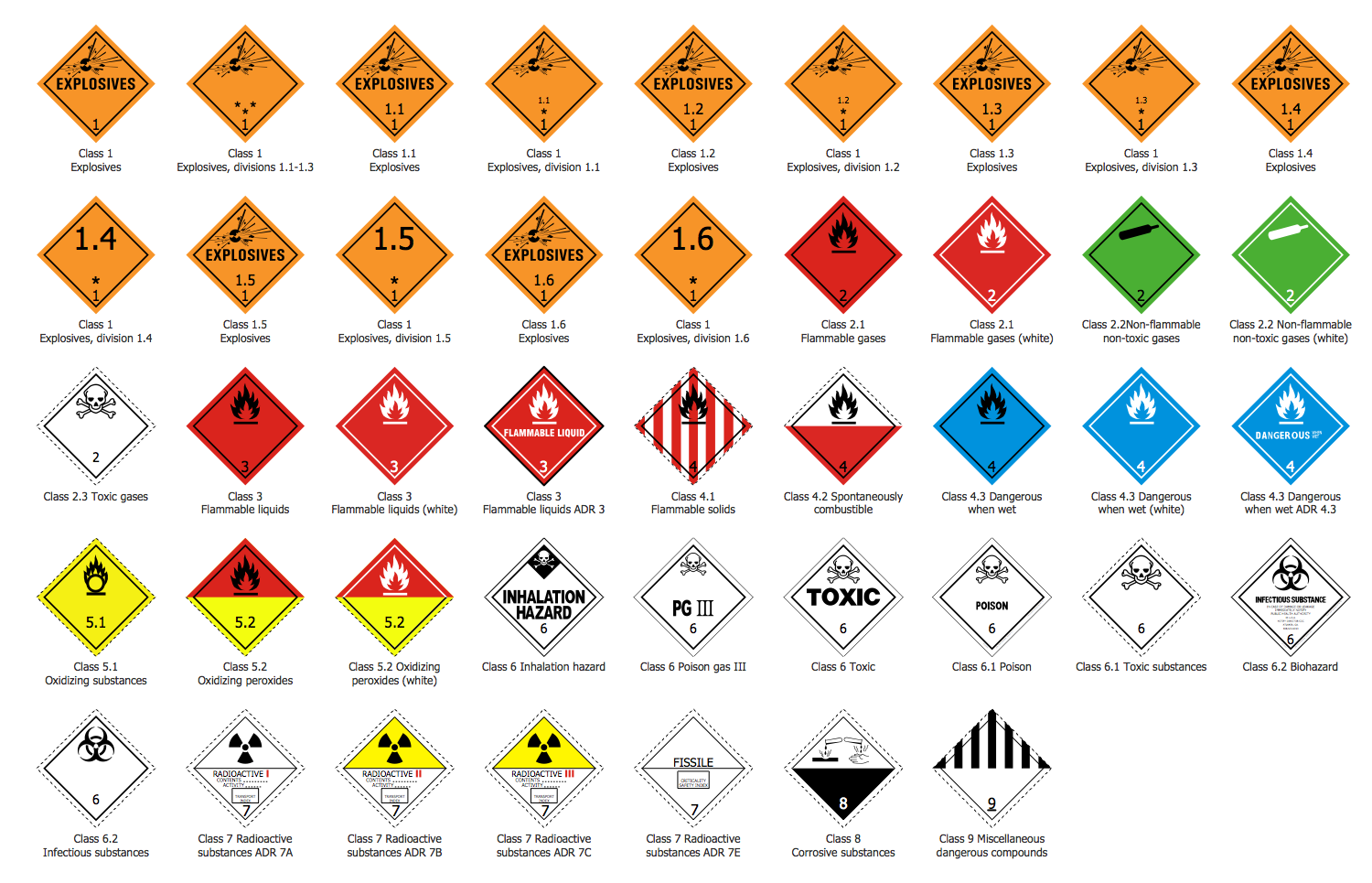
Related News:
Examples
There are a few samples that you see on this page which were created in the ConceptDraw DIAGRAM application by using the Transport Hazard Pictograms solution. Some of the solution's capabilities as well as the professional results which you can achieve are all demonstrated here on this page.
All source documents are vector graphic documents which are always available for modifying, reviewing and/or converting to many different formats, such as MS PowerPoint, PDF file, MS Visio, and many other graphic ones from the ConceptDraw Solution Park or ConceptDraw STORE. The Transport Hazard Pictograms solution is available to all ConceptDraw DIAGRAM users to get installed and used while working in the ConceptDraw DIAGRAM charting and drawing software.
Example 1: ADR 2007 Labels of Danger
This diagram was created in ConceptDraw DIAGRAM using the Transport Hazard Pictograms library from the Transport Hazard Pictograms Solution. An experienced user spent 20 minutes creating this sample.
This sample represents the table of symbols of danger along with the labels for them according to the European agreement about international transport of hazardous goods by road or Accord européen relatif au transport international des marchandises Dangereuses par Route (ADR) from 2007. The classes of dangerous goods according to ADR include the following 9 ones: class 1 — explosives, class 2 — gases (flammable, non-flammable, non-toxic, and toxic), class 3 — flammable liquids, class 4 — flammable solids, self-reactive substances, solid desensitized explosives, substances liable to spontaneous combustion solids that in contact with water, emit flammable gases, class 5 — oxidizing substances, organic peroxides, class 6 — toxic substances, infectious substances, class 7 — radioactive materials, class 8 — corrosive substances, class 9 — miscellaneous dangerous substances and articles. Most of them are presented in this table and are used for marking hazardous cargo in transnational railway transportations and international maritime deliveries.
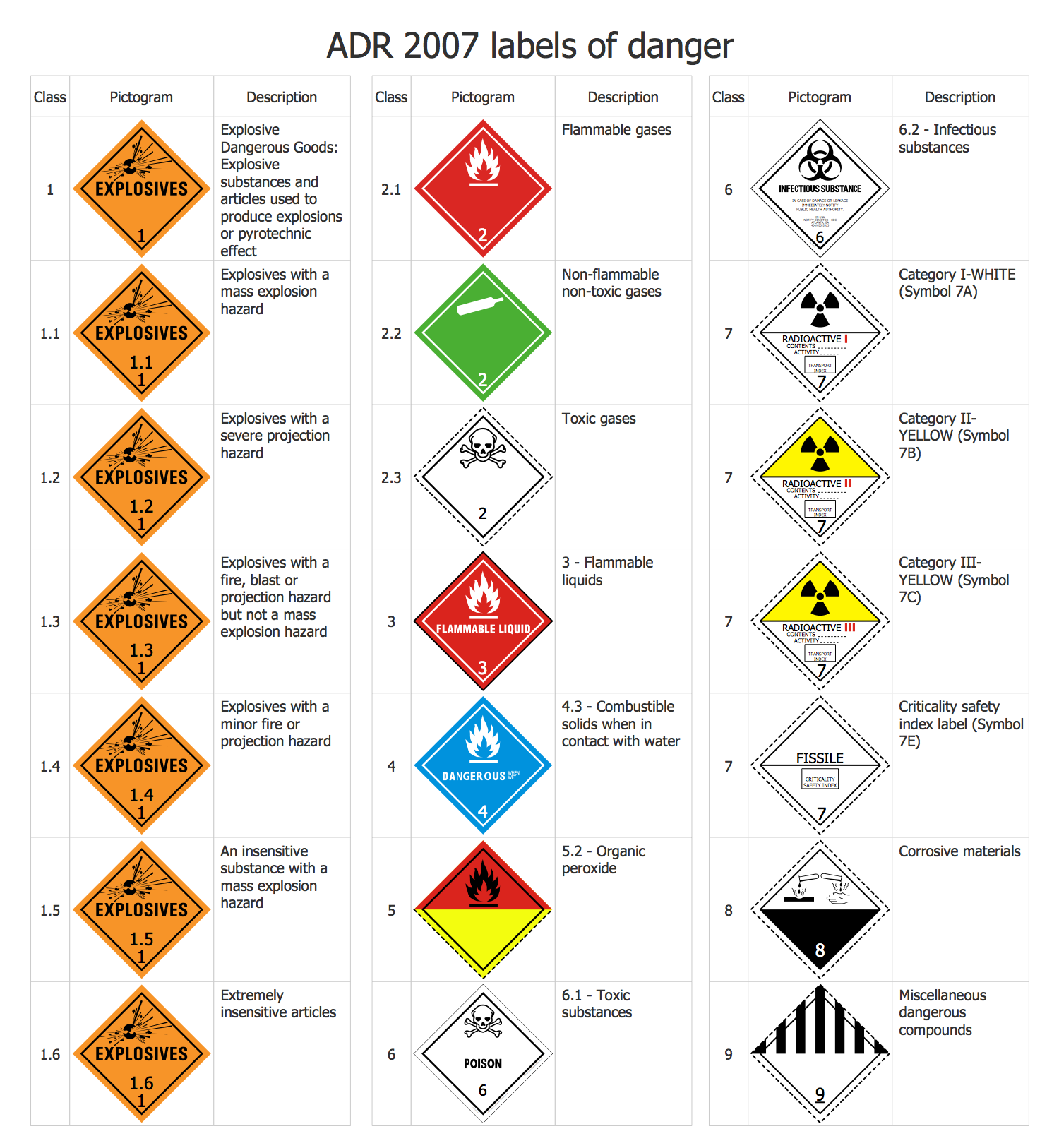
Example 2: ADR Pictograms
This diagram was created in ConceptDraw DIAGRAM using the Transport Hazard Pictograms library from the Transport Hazard Pictograms Solution. An experienced user spent 5 minutes creating this sample.
This infographic presents a table of ADR pictograms with an indication of the hazard class and its name under each pictogram hazard. ADR (abbr. derived from the French name Accord européen relatif au transport international des marchandises Dangereuses par Route) is an European Agreement towards the International Carriage of Dangerous Goods by Road. This document regulates transnational transportation of hazardous materials. It contains general requirements, explains specific terminology, classifies dangerous goods, sets norms for construction and testing equipment and vehicles used for transportation, describes the conditions of carriage, loading, unloading, and handling, items of the dispatch procedure, establishes certain rules for packaging and a list of special pictograms for labeling cargo of this kind, containers, and vehicles. The document was constructed in a few minutes and can be easily repeated due to the set of ready-made vector ADR and hazard communication pictograms offered in the solution’s Transport Hazard Pictograms library.
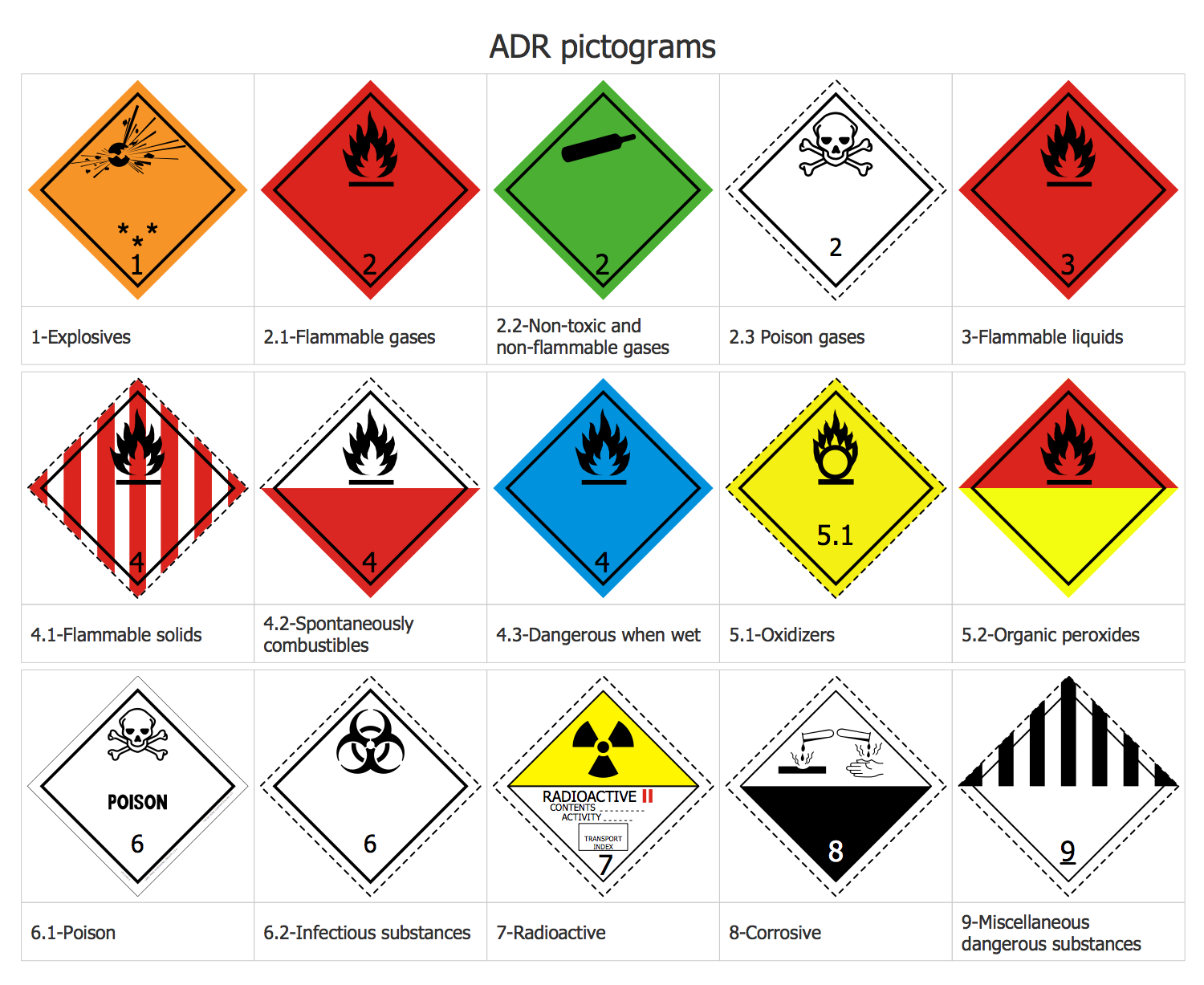
Example 3: GHS Pictograms
This diagram was created in ConceptDraw DIAGRAM using the Transport Hazard Pictograms library from the Transport Hazard Pictograms Solution. An experienced user spent 10 minutes creating this sample.
GHS (Globally Harmonized System of Classification and Labeling of Chemicals) was developed as a way to create a unified system of standards for different countries and realize the chemical regulations. The GHS pictograms are important elements for labeling containers, warehouses, workplaces, and vehicles transporting the chemicals. They are used in chemical product descriptions, hazard statements, and warning words to warn of danger, reduce environmental risks and save human lives. There are five groups of GHS pictograms: physical hazards pictograms, health hazards pictograms, environmental hazards pictograms, transport pictograms. This infographic example talks about GHS hazard pictograms and shows them all with names in one diagram. One can pay attention that hazard pictograms use a wide spectrum of colors and may contain a class number, if it includes several divisions, along with the comprehensive graphical symbols and labeling under the pictograms. Some of these symbols are identical to the ADR pictograms intended for marking when transporting dangerous goods.
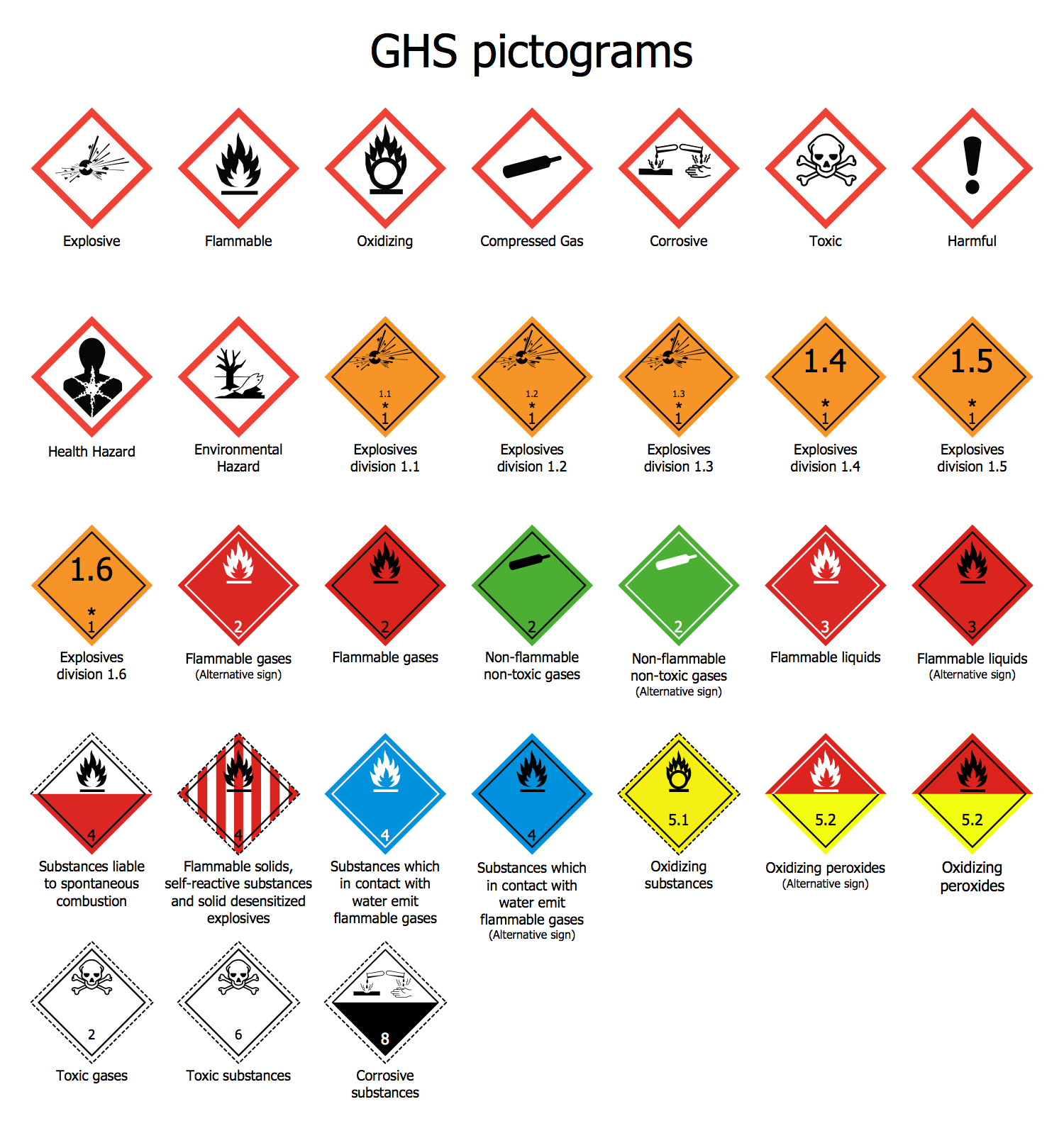
Example 4: Transport Pictograms
This diagram was created in ConceptDraw DIAGRAM using the Transport Hazard Pictograms library from the Transport Hazard Pictograms Solution. An experienced user spent 5 minutes creating this sample.
This transportation safety infographic illustrates the table of all transport hazardous symbols, which groups them according to the hazard class. These signs are used to indicate transport hazards. Class 1 includes explosives, class 2 — gases, classes 3 and 4 — flammable liquids and solids, and classes 5-9, which contain oxidizing substances, organic peroxides, toxic substances, infectious substances, radioactive materials, corrosive substances, other dangerous substances and products, including substances hazardous to the environment. The transport icons have a square shape turned at an angle of 45°, outlined inside, in the upper corner is a symbol indicating danger, and in the lower corner there is a class number and, possibly, a subclass. The pictogram may contain words that indicate a hazard, for example "flammable substance". The Symbols, numbers and text should be black, unless they are on a colored background and painted white. To draw special attention, most GHS transport pictograms have a bright or contrasting background.
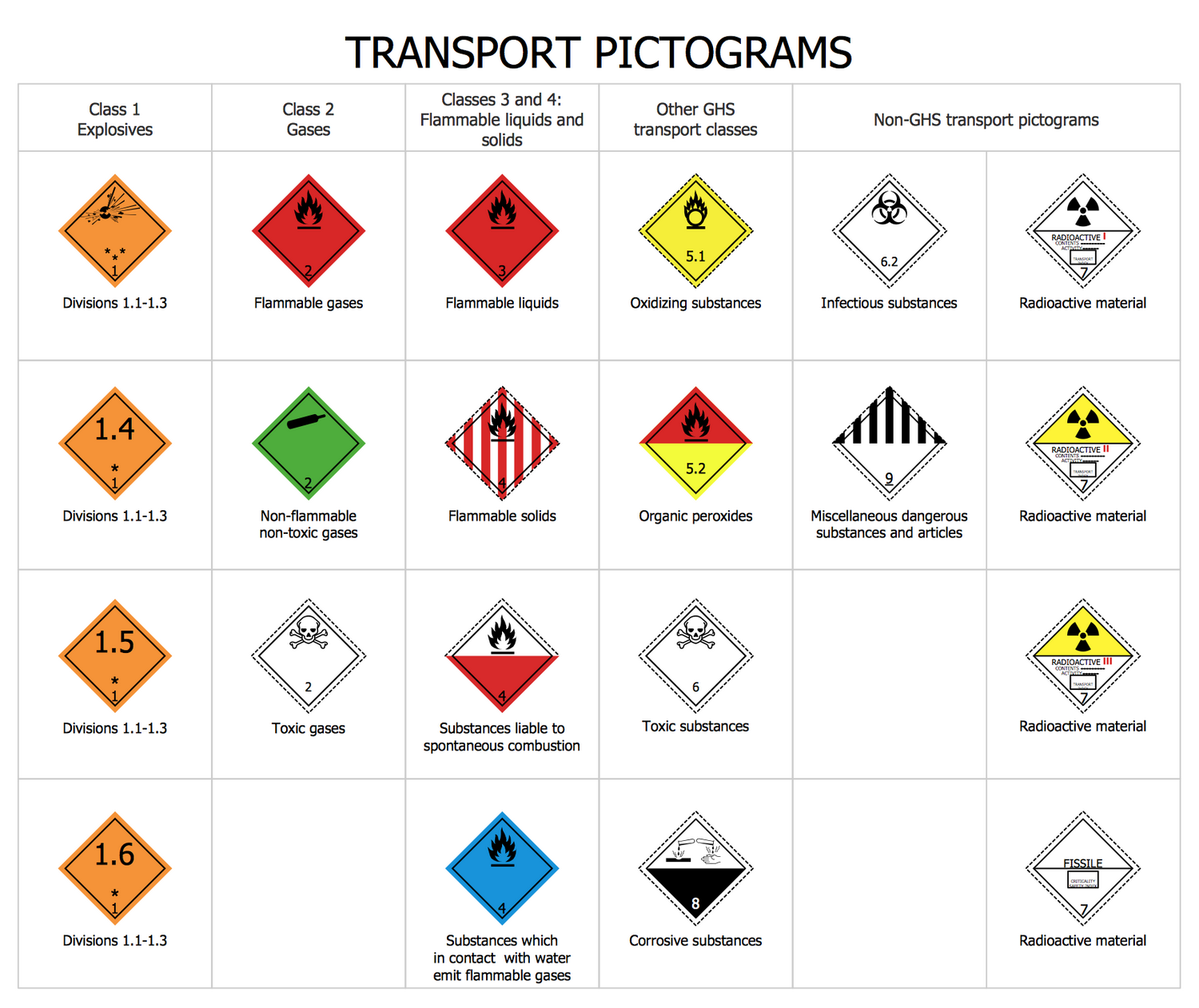
Example 5: Worldwide Hazard Pictograms
This diagram was created in ConceptDraw DIAGRAM using the Transport Hazard Pictograms library from the Transport Hazard Pictograms Solution. An experienced user spent 20 minutes creating this sample.
This sample infographic provides a complete list of transport hazards pictograms, which are well-known and used around the world. The hazard pictograms are included in the Globally Harmonised System of Classification and Labelling of Chemicals (GHS) and were developed as a way to facilitate worldwide trade, and protect human health and the environment. This table provides an informative description in a convenient and visual form, indicates classes and types, as well as detailed descriptions of the use and additional notes for all pictograms. Each of these diamond-shaped pictograms gives a pictorial presentation of a particular hazard, indicates the nature of the hazard associated with the use of a hazardous substance or mixture. This classification makes it easy to determine if your substance or mixture is dangerous and according to the label which hazard class it belongs to. Use the ConceptDraw DIAGRAM to easily create your own hazard warnings and graphic illustrations with them.
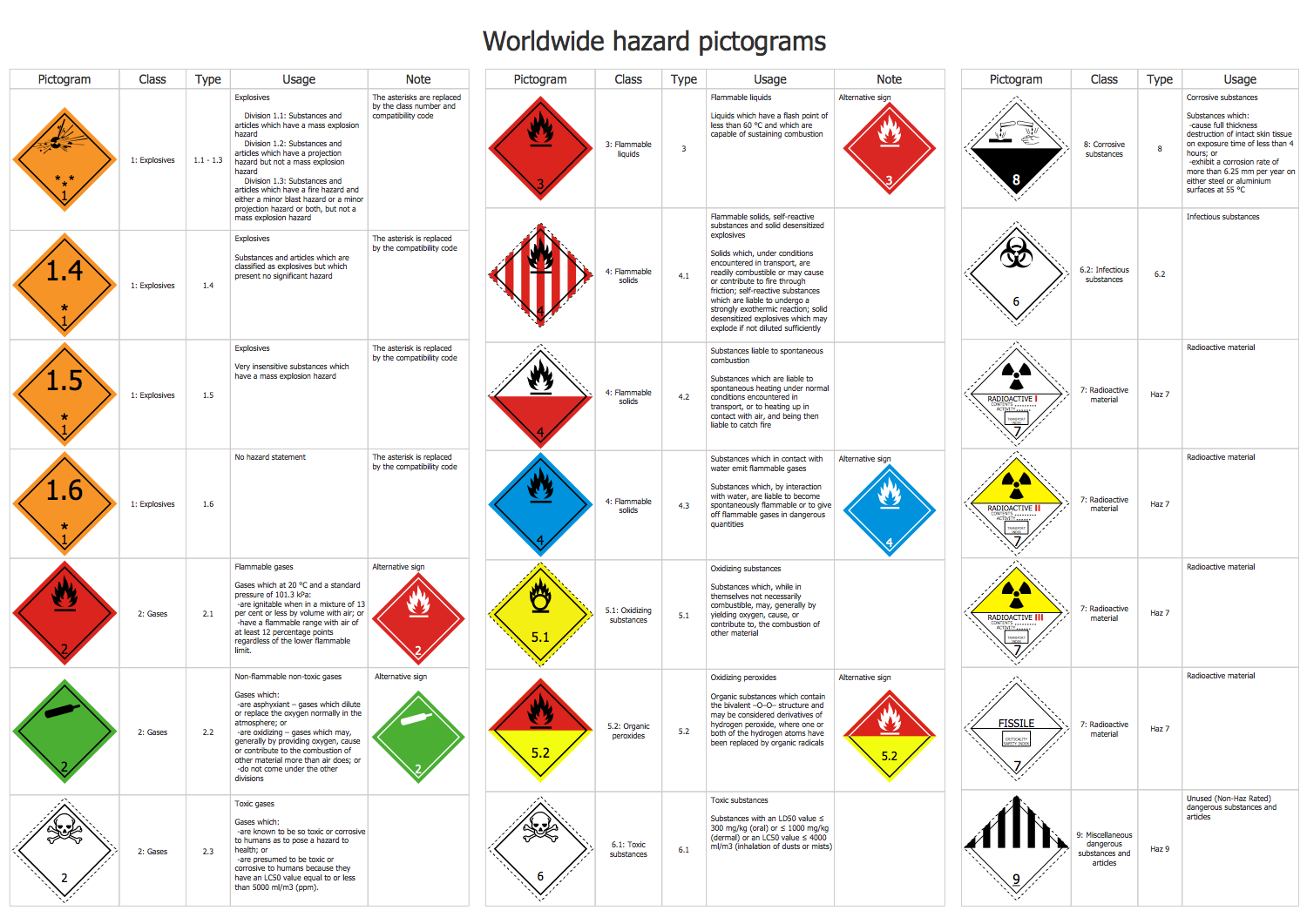
Inside
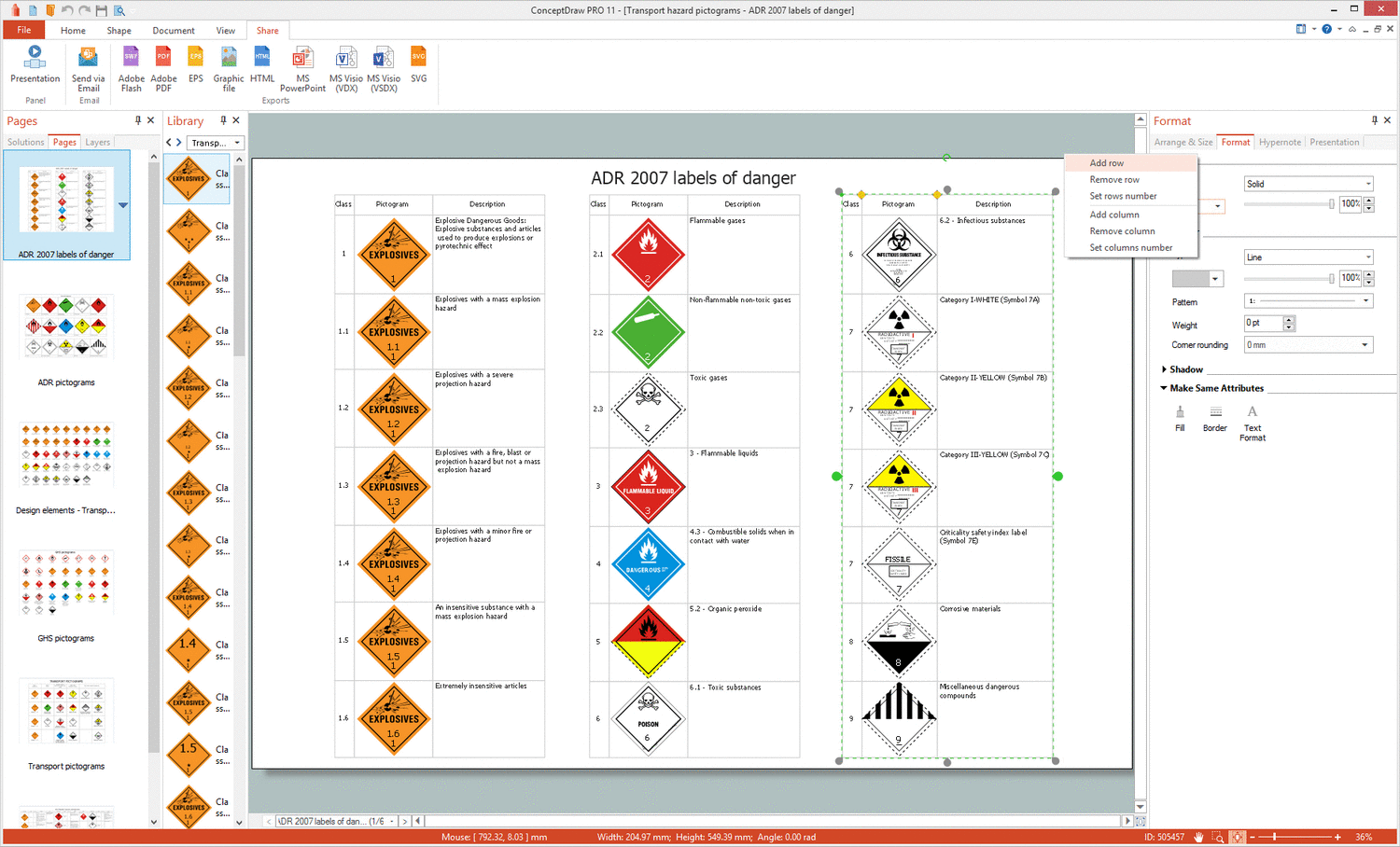
What I Need to Get Started
Both ConceptDraw DIAGRAM diagramming and drawing software and the Transport Hazard Pictograms solution can help creating the illustrations the technical documentation of an engineering projects you need. The Transport Hazard Pictograms solution can be found in the Industrial Engineering area of ConceptDraw STORE application that can be downloaded from this site. Make sure that both ConceptDraw DIAGRAM and ConceptDraw STORE applications are installed on your computer before you get started.
How to install
After ConceptDraw STORE and ConceptDraw DIAGRAM are downloaded and installed, you can install the Transport Hazard Pictograms solution from the ConceptDraw STORE.
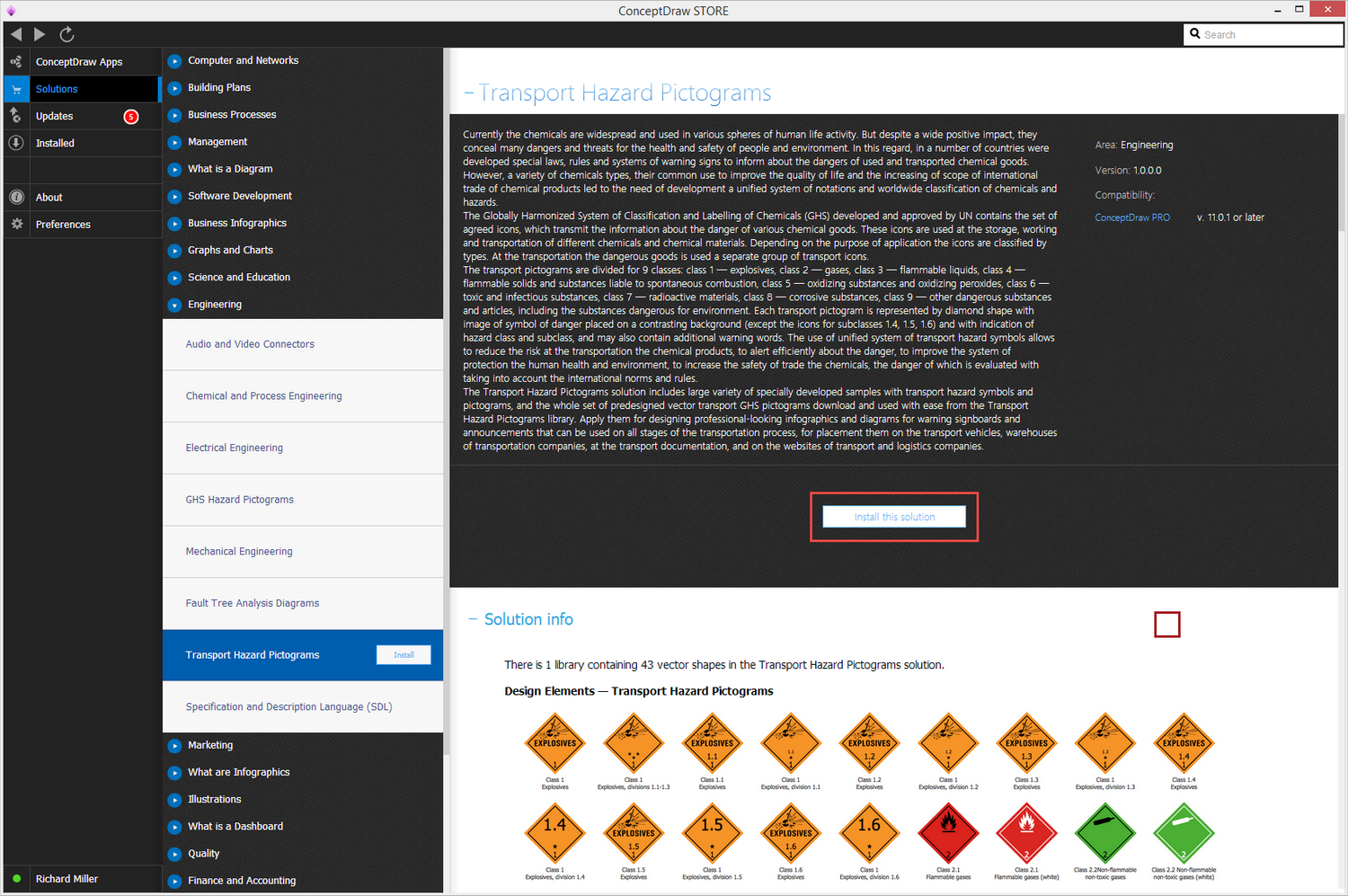
Start Using
To make sure that you are doing it all right, use the pre-designed symbols from the stencil libraries from the solution to make your drawings look smart and professional. Also, the pre-made examples from this solution can be used as drafts so your own drawings can be based on them. Using the samples, you can always change their structures, colors and data.
